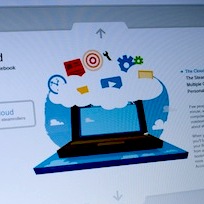
AVG LiveKive joins crowded online backup market
AVG has launched a beta of its brand new online backup service. LiveKive will offer cloud-based backup, synchronising and file-sharing for its users, and the beta version launches with a one-size-fits-all free storage plan of 5GB for a year. No paid-for packages are currently available while LiveKive remains in beta.
Once signed up through the AVG landing page, users can then download the backup client, currently codenamed AVG AirSpace. This is a rebadged version of the same client used by rival online backup provider, SpiderOak.

Risk-averse enterprises get Google relief: They can delay and schedule Apps upgrades
If there is one truism about IT organizations -- they're risk averse. Some are so against making changes they even take unnecessary risks to avoid others, like continuing to use Internet Explorer 6 even as Microsoft pushes hard to get businesses on a more modern, and safer, browser. Today, Google extended a concession to IT organizations by offering a second track for Google Apps that lets IT organizations delay and take seemingly more control over upgrades. The program smacks against one of cloud computing's benefits: Seamless and seemingly maintenance-free upgrades.
Google Apps' administrators can now choose "Rapid Release" or "Scheduled Release" options. The first track assures that users have the most up-to-date software. The second allows administrators to delay updates, which will be released to them on Tuesdays. Google provides a calendar of planned upgrades, seven days in advance of new features' release.

Chrome 10 seeds Google's Cloud OS ambitions
Google is preparing anyone using Chrome 10, which released yesterday, for launch of Chrome OS. The new standalone browser has reached feature parity -- for business, consumer or IT pro evaluator users, anyway -- with Chrome OS browser front-end running on Google Cr-48 laptops. Chrome 10 is a much bigger browser release than even Google's boasting -- "speedier, simpler, safer" -- lets on. Google is beginning its biggest push yet to the cloud, and Chrome OS is quickly, and I do mean quickly, approaching v1 release. Apple and Microsoft had best watch out, because among major platform developers they have the most to lose should Google's cloud ambitions succeed.
Chrome 10's standout features, at least for cloud computing, all begin with "s": sandbox, search, services, simplicity, security, settings, speed, stability and synchronization. Many of these attributes interrelate or aren't new to this browser release -- they're improved for cloud readiness.

Tip: Access your files in the cloud from iPad and iPhone
Online backup providers are ten-a-penny these days, so finding your own unique selling point in an increasingly crowded market takes a little bit of thought. SpiderOak has been selling online backup space for around 18 months now -- it's not the cheapest option, but it does boast a user-friendly client that makes the whole backup process that little bit easier. It works across Windows, Mac and Linux, and it's capable of syncing folders between different computers to ensure you always have access to the latest versions of your files, whatever computer you're sitting at. SpiderOak also offers a free iPhone app, recently updated to version 1.2 with full iPad support, which allows you to access and use your backup files directly from your mobile device.
The great thing about SpiderOak is that it offers a free lifetime's 2GB worth of storage, believing that when you use that up you'll want to upgrade to a subscription offering more storage. That's all well and good, but SpiderOak charges $100 a year (or $10 a month) for 100GB storage space. That's off-putting to many, and it's a shame it doesn't follow Wuala's example in offering smaller packages for less (such as its extremely competitive entry level 10GB package for just €19 a year).

Chrome OS update makes Google Cr-48 worthy cloud PC alternative
This week, I unexpectedly started using Google's Cr-48 notebook running Chrome OS as my production system. On Monday, my 11.6-inch MacBook Air fatally crashed, leaving no real alternative since a friend has my Windows laptop. So I fired up the Cr-48, which I reviewed in December in seven parts. It has been a great week that got better after installing yesterday's Chrome OS update -- "0.10.156.46 (Official Build caa798a8)."
I started using the Cr-48 full time a second time with sense of urgency. I couldn't fall back to MacBook Air. It was sink or swim. Treading water wouldn't be good enough. Swim I did: As a work replacement PC, the Cr-48 has proved its worthiness, with Chrome OS obviously being major reason; Google synchronization is another. This second week's use also has me reconsidering the merits of the browser as a user-interface motif.

Report: Apple negotiating for unlimited music downloads
MobileMe's expected refresh was notably absent from Apple's event Wednesday announcing the debut of the iPad 2, however Cupertino may be working behind the scenes to make a revamp of the cloud service part of a larger push towards streaming content.
Sources have told Bloomberg that Apple is currently in negotiations with several record labels including Universal, Sony, Warner, and EMI with hopes that an agreement could be reached by midyear. Apple wants the labels to allow unlimited access to their content across multiple devices.

BackupGoo: Affordable safety net protects your Gmail data
Few people give a second thought to files and data stored in the cloud, but just like local data, it is important to backup online information. The recent problems suffered by Google Gmail highlights the importance of ensuring that your online data is safeguarded, and BackupGoo provides a quick and easy way to back up your Google account in its entirety.
After providing your Google username and password, the application is able to access your account and can then be used to download your emails, documents, calendars, contacts and more. If you do not use all of Google's services -- not everyone has a need for Google Docs, for instance -- you can select precisely what you would like to backup and where the files should be stored on your hard drive.

Google's Chrome OS laptop saved my butt
My March started off badly today.
When I was a school kid in Maine, teachers said that if March roared in like a lion, meaning snowy stormy, it would go out like a lamb -- and vice versa. I got the storm in a faulty Snow Leopard rather than the Lion. This morning my 11.6-inch MacBook Air crashed and wouldn't reboot. If not for moving my computing life to the cloud, I would have lost an important day of productivity and lots of valuable data.

Google: Gmail access restored soon to all affected
Google said late Monday that it would have e-mail access restored to those who found themselves locked out of their accounts due to a glitch in a storage update applied to Gmail servers on Sunday. The company noticed the update was malfunctioning and pulled it before it could cause additional trouble.
As opposed to the .08% of all Gmail users affected, Google revised that number down to .02%. This translates to about 34,000 or so locked out of their accounts, versus the 136,000 originally thought to be affected.

Gmail outage locks some users out of e-mail
Google was still working to restore access to its Gmail e-mail service to a handful of customers on Monday, a day after an outage prevented a few users from accessing their e-mails. A message posted to the Google Apps status page at 10:40pm Eastern Sunday said engineers were "working to restore full access," and full access would be restored in the "near future."
No update had been provided as to if the issue had been fully resolved, although the company noted the issue affected only .08% of the total Gmail user base.

One IT pro explains why he fears and embraces disruptive cloud and mobile platforms
Betanews welcomes reader contributions. Here, Eric Neumann responds to two February 21st posts by Joe Wilcox -- "iPad is not a PC" and "5 reasons Macs will never outsell PCs." If you would like to submit a post, please email joewilcox at gmail dot com.
Being a business IT professional, I have been watching with great interest and excitement the emergence of the iOS model of computing and cloud movements hitting the personal and now commercial computing worlds. However, I must add that initially I have also viewed these big changes with fear; as recently as 2006, my career was purely based on the SME IT status quo of on-premise Microsoft and LAMP (Linux, Apache, MySQL, PHP) stacks.

Google launches its next assault on "cumbersome, legacy" Microsoft Office
In the race to offer Microsoft Office functionality in the cloud, Google has beaten its rival getting a product out of development beta and into production release. Today Google announced global availability of Google Cloud Connect for Microsoft Office, which went into beta late last year. The technology builds off Google acquisition of DocVerse.
Microsoft is working on its own solution, Office 365, which is beta testing and is expected to go v1 sometime this year. For now, Google can claim first to market advantage as it looks to convert more Office users to its cloud services. The cloud is increasingly important to Microsoft. Last year, COO Kevin Turner said that 70 percent of cloud wins are new customers.

Google fights Facebook for your mobile identity
Who owns your mobile/online identity? Stated differently: Who owns your mobile relationships?
I've been thinking more about both questions since learning last night that Google is pulling Facebook contact sync with delivery of Android 2.3.3 to Nexus S smartphones. In a statement, a Google spokesperson described the feature removal as "special-case handling of Facebook contacts" for "Nexus S and future lead devices." Google's reasoning: Facebook doesn't allow exporting of contact data to other services. There is no "reciprocity." Maybe, but there is more going on here than the openness, or not, of contact syncing. Google is prepping for a larger battle, particularly with Facebook, over who controls your online identity, particularly as it roams from PC to mobile devices.

Amazon Prime just got better: Free movie and TV show streaming
One of Amazon's best values is its Prime service, which costs $79 a year. For that fee, buyers get free two-day shipping or overnight packages for $3.99 per item. Today, Amazon added something more: free streaming of 5,000 movies or TV shows. Or so the retailer claims. I only see 1,688 movies and 484 TV shows currently available on Amazon Instant Video.
Amazon offers a surpringly good selection, too; that is sure to give Netflix some unexpected and needed competition in the streaming market, and Prime is a better value. Netflix charges $7.99 per month (before taxes) for movie and TV show streaming, or minimum $95.88 a year. Not only does Prime cost less but it offers more in the aforementioned shipping costs -- and there's something else: Amazon allows the sharing of Prime among four accounts in the household. If, say, you're a college student with roomies sharing Primes, the value just got whole lots better.

Google One Pass gives back what Apple's iPad subscription plan takes away
Well, that didn't take long. One day after Apple dropped its subscription plan bomb on suspicious publishers, Google officially countered with One Pass. Google strips out the onerous restrictions Apple imposes. It's a brilliant marketing response, and aptly timed with new Android tablets like the HTC Flyer, Motorola XOOM and Samsung Galaxy Tab 10.1 going on sale within weeks. More significantly, the program isn't restricted to mobile devices. Can you say Internet?
Apple's subscription plan places many restrictions on publishers. Apple takes a 30-percent commission on all sales, requiring publishers to offer prices the same or lower in-app as elsewhere; that hugely limits promotions, for example. Apple's plan would prevent publishers from making in-app subscriptions free as a benefit to existing subscribers elsewhere (e.g., consumers pay more because of Apple policies). Publishers will likely loose access to vital customer data, since Apple is requiring an option that lets subscribers opt-in to this disclosure.
